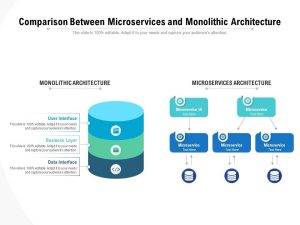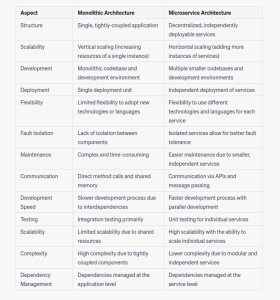Amidst the growing popularity of microservices among businesses, the question arises: “Should we transition to microservice architecture?” The answer, however, is not so straightforward.
According to Farley, co-author of Continuous Delivery with Jez Humble, many individuals are implementing what they perceive as microservices, but in reality, they are not true microservices. Often, concepts like containers and APIs are mistakenly equated with microservices.
Therefore, it is crucial to delve deeper and gain a clear understanding of both monolithic and microservice architectures, in order to determine which approach is best suited for your specific needs. Explore the nuances of Monolithic Vs. Microservices and make an informed decision for your business’s future.

What is Monolithic Architecture?
Monolithic architecture refers to an architectural design that relies on a single code base encompassing all components, including business logic, data, and associated code.
When comparing Monolithic Vs. Microservices, it’s essential to understand the fundamental components of Monolithic Architecture. This architectural approach consists of three main parts:
- Database: The database serves as the central repository, responsible for storing all data within the system.
- Client-side user interface: This component stores HTML or JS pages that are executed directly from the user’s browser, enabling the presentation and interaction with the application.
- Server-side application: The server-side app handles user requests and executes the necessary logic to process those requests.
To illustrate the concept of Monolithic Architecture, let’s use an analogy. Imagine constructing a home using a single colossal piece of wood. All aspects of the house, including walls, windows, and intricate details, are crafted solely from that massive piece of wood. Similarly, Monolithic Architecture follows a similar principle, where every part of an application is built on a single code base.
By exploring the distinctions between Monolithic Vs. Microservices, you can make an informed decision regarding the ideal architectural choice for your business.
Advantages of Monolithic Architecture
- Simplified debugging: With a single codebase, developers can easily trace and troubleshoot errors, eliminating the need for guesswork and making debugging more straightforward.
- Established and proven: Monolithic architectures have a long history of successful implementation in various organizations. They have been tried, tested, and proven to work effectively, providing a reliable and stable option compared to newer, untested services.
Disadvantages of Monolithic Architecture
- Unsuitable for DevOps: Monolithic architectures pose challenges in implementing DevOps practices that emphasize breaking down large components and optimizing the development process. The tightly coupled nature of monoliths makes it difficult to achieve the desired flexibility and agility.
- Limited scalability: Scaling individual elements becomes challenging in a monolithic architecture due to the lack of inherent flexibility. Scaling the entire application is necessary, even if only specific components require additional resources.
- Technological inflexibility: Since monolithic architectures rely on a single technology stack, incorporating new technologies or making technological advancements becomes more cumbersome. Changes in technology impact the entire application, potentially limiting the ability to adapt and adopt new innovations.
- Vulnerability to failures: As the codebase is centralized, any bugs or issues within the application can have a widespread impact, affecting the entire system’s reliability and performance.
By evaluating the trade-offs between Monolithic Vs. Microservices , businesses can make informed decisions regarding the most suitable architectural approach for their specific needs.
What is Microservices architecture?
Microservices architecture is a contemporary modular approach that decomposes an application into small, independent units known as microservices. Each microservice operates its own set of processes and communicates with other services through APIs.
One of the key advantages of microservices architecture is its loose coupling. This means that if one microservice experiences an issue or breaks down, the other microservices can continue to function independently, ensuring system stability. According to Gartner, software engineers often favor microservices as they enable continuous delivery and promote agile development practices.
By contrasting Monolithic Vs. Microservices , organizations can assess the trade-offs and benefits of each architectural style to determine the most suitable approach for their specific requirements.
Advantages of Microservices Architecture
- Agile-friendly: Microservices architecture is well-suited for Agile teams as it facilitates frequent code deployment, enabling rapid iterations and faster development cycles.
- Continuous deployment for faster releases: With microservices, updates and enhancements can be pushed to the application on a regular basis, reducing the need to wait for specific release cycles. This leads to faster releases and enables businesses to respond quickly to changing requirements or market demands.
- Enhanced reliability: Microservices architecture allows for isolated changes to specific parts of the application without affecting the functionality of other services. This provides a higher level of reliability as updates or modifications can be made to one microservice without causing downtime or disruptions in other parts of the system.
Disadvantages of Microservices Architecture
- Increased cost: The adoption of microservices architecture can lead to exponential cost growth. Each microservice requires its own testing infrastructure, dedicated development team, and separate hosting architecture, resulting in higher operating costs. As the number of microservices increases, so does the complexity and overhead costs associated with managing them.
- Challenging debugging process: Debugging in a microservices environment can be more complex compared to a monolithic architecture. Since a single function may span across multiple microservices, identifying and resolving errors becomes a significant challenge, requiring thorough testing and monitoring strategies.
By evaluating the trade-offs between Monolithic Vs. Microservices, organizations can assess the advantages and disadvantages of each architectural approach to determine the most suitable fit for their specific business needs.
Comparing Technologies for Developing Monolithic Architecture & Microservice Architecture

Having clarified the definitions of Monolithic Vs. Microservices, let’s now delve into the comparison between these two approaches and determine which one aligns better with your needs and requirements.
When to Use a Monolithic Architecture and When to Use Microservices?
Before making a decision, it’s important to consider several factors that can help guide your choice between Monolithic Vs. Microservices. Let’s explore these factors in relation to the “Monolithic Vs. Microservices” comparison.
- Complexity of the project: Monolithic architecture is well-suited for simpler applications such as basic e-commerce stores, blogs, or websites. On the other hand, if your application is highly complex and experiences high traffic, like Netflix, Microservices architecture might be the better choice.
- Budget: Budget plays a significant role in the decision-making process. Implementing Microservices architecture requires specialized teams with prior experience working with containers and the microservice ecosystem. Additionally, each microservice typically requires its own dedicated team. Considering your budgetary constraints is essential.
- Speed: If your development teams prioritize faster development and deployment, Microservices architecture may be more suitable. Its modular nature allows for independent development and deployment of services, enabling teams to work concurrently and achieve higher speed.
- Organization growth: Microservices can facilitate exponential scalability as your organization grows rapidly. The decoupled nature of Microservices allows for independent scaling of specific services, accommodating increased demands and ensuring seamless growth.
- By considering these factors in the context of “Monolithic Vs. Microservices,” you can make an informed decision that aligns with your specific needs and requirements.
Is Microservices Architecture Better Than Monolithic Architecture?
In the final analysis, determining the optimal choice between Monolithic Architecture and Microservices rests on the specific needs and objectives of your business. Monolithic Architecture presents the advantages of simplicity and ease of development, whereas Microservices offer scalability and flexibility.
To arrive at an informed decision, it is crucial to take into account factors such as the size of your project, the capabilities of your team, future growth plans, and resource constraints. It is important to recognize that there is no universally applicable solution, as what proves effective for one organization may not be ideal for another. Instead, embrace the transformative potential of understanding and select the architectural approach that empowers your business to flourish within the ever-evolving digital landscape.
Transitioning to Microservices Made Easy with Clarion Technologies
If your business is experiencing rapid growth that surpasses your current scaling capabilities, it’s essential to seek the assistance of a skilled workforce to establish a robust microservice architecture. By collaborating with like-minded developers from Clarion Technologies, you can construct a highly scalable system that empowers your business to expand exponentially.
With their expertise in navigating the nuances of “Monolithic Vs. Microservices,” Clarion Technologies can guide you in making the right architectural choice and implement a solution that aligns with your growth objectives. Don’t let scaling limitations hold your business back—leverage the power of microservices to unlock your business’s true potential.

